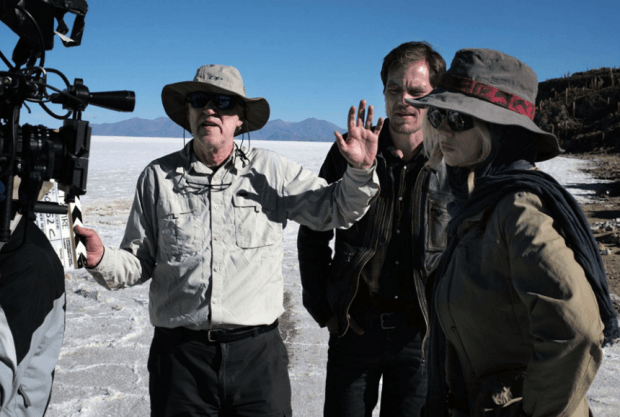
“Did you drink some sort of strange herbal tea this morning?”
That question, asked of me by Werner Herzog as I probed his thoughts on whether his films are about the environment, was a firm indication that our conversation wouldn’t stay on any predetermined path. When I spoke with Herzog for MovieMaker‘s Winter 2017 issue to feature him as one of three of our choices for this year’s “Moviemaker of the Planet,” there was some hope that the German iconoclast would be pining over the fate of the earth’s atmosphere as much as I was, after newly-elected President Trump assumed the reigns of power as America’s resident climate-denier-in-chief. But for someone whose films are so transfixed by the bleak indifference of the natural world, he remained pretty optimistic about a green future under the aforementioned orange ignoramus.
The reason for our talk was the recent release of Salt and Fire, a film nominally about an “ecological disaster” caused by a reckless CEO (Michael Shannon) and investigated by two U.N.-sanctioned ecologists, (Veronica Ferres and Gael García Bernal) but more of a long-form poem about abandonment, loss and longing than a tirade on Earth’s decay. Starting with a discussion about the nature of what “documentary,” “fiction” and “science-fiction” actually are, we somehow moved to an exchange on Herzog’s driving and food conservation habits, then to his strange fascination with Mike Tyson, and of course, inevitably, to his thoughts on Trump.
Read on for the interview, which reveals Herzog as a moviemaker and thinker equal parts droll and troll.

Max Weinstein, MovieMaker Magazine (MM): You’ve made many documentaries—
Werner Herzog (WH): No, no, no, wait, wait. I’ve never made a documentary. They are all feature films disguised in a way.
MM: Well, they’re films that you could say depict the natural world in a non-fiction context. And you could have gone that route with Salt and Fire to address environmental concerns, but didn’t. The film is instead a work of fiction and has been described as an “ecological thriller…”
WH: I have to stop you. It is not an “eco-thriller.” It’s labeled an “eco-thriller,” but it’s nothing to do with it. It’s about a mysterious hostage taking, and a woman stranded deliberately with two blind boys in a salt desert. Nobody has seen the film. But on the internet, somebody has started to label it as an “eco-thriller,” not having seen a second of the film. The internet is not reliable.
MM: That’s a fair point, but having seen the film, I was fascinated just the same by the ecological disaster around which it’s centered.
WH: You’re still asking with strange limitations, as if it was a film on ecology. You are desperately trying to find some sort of an ecological enge.
MM: [Laughs] Well, if you’re saying that the environment is not of interest to you in your work, then that’s also interesting…
WH: But no, I did not say that. To some degree, probably yes. But it’s not the main theme. The environmental question, of course, is looming, somehow…
MM: That plot device is, at least, the backdrop of the film. So, why was it of importance to you to set such heavily stylized, philosophical dialogue against that backdrop?
WH: You are trying to compare, now, the ecological thriller with odd dialogue. When you point to the dialogue, it is about anamorphic art, and it is about a saint under a tree in a cloister in Rome. When you get closer to the saint, the more strange the image becomes. When stretched out, the saint morphs into a landscape. The ecological thing is completely fictitious. It doesn’t exist. The ecological disaster doesn’t exist. It is fictitious.
MM: That’s true, it doesn’t exist. Rather than imagine an environmental disaster in the way that a climate science film or an apocalyptic blockbuster would, Salt and Fire instead pretends that the Bolivian Uyuni salt flats are the site of all water on Earth becoming dried up. Why did you choose the salt flats as a visual metaphor for decay—especially when they’re a rather innocuous site for tourists in real life?
WH: The salt flats are so cinematic. They are so beautiful and so strange. When you are there—and you see it in the film—it doesn’t look as if I were filming on our planet. It looks like some sort of a foreign world somewhere out in a different galaxy.
MM: You’ve described some of your films, like Lessons of Darkness, as “science-fiction” for that very reason: that they seem to be narrated by a visiting alien being, and their images seem to be of a world that is not our own. Why is that concept important for you as a moviemaker when engaging with the natural world?
WH: Well, when you are visiting a landscape like Kuwait, when everything was burning, when all the oil wells were burning, the moment I arrived there I had the feeling that “This is not our planet anymore.” You cannot recognize it. There’s something different that we are seeing. And because of that, I declare what we see as images from a different planet. And of course when you take the quasi-perspective of an alien, you start to look at our world with a different perception. And that becomes very interesting in movies.

